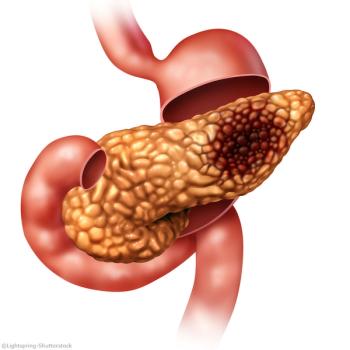
- ONCOLOGY Vol 17 No 12
- Volume 17
- Issue 12
New Approaches for Combining Chemotherapy and Radiation in the Treatment of Non-Small-Cell Lung Cancer and Pancreatic Cancer
Both advanced nonSMQ-8211-SMQsmall-cell lung cancer and pancreatic cancer pose significanttherapeutic challenges to clinicians due to their high mortalityrates. The past 2 decades witnessed an evolution in the approach to thetreatment of these diseases. In metastatic nonSMQ-8211-SMQsmall-cell lung cancer, trials ofrecently developed chemotherapy regimens have shown increased response ratesand improved quality of life. Several large, randomized phase III trials in unresectablenonSMQ-8211-SMQsmall-cell lung cancer have demonstrated that treatment with chemotherapyand radiation in combination leads to superior outcomes compared with radiationalone. This supplement highlights current treatment options with chemoradiationfor patients with advanced nonSMQ-8211-SMQsmall-cell lung cancer and pancreatic cancer.
Both advanced non-small-cell lung cancer and pancreatic cancer pose significant therapeutic challenges to clinicians due to their high mortality rates. The past 2 decades witnessed an evolution in the approach to the treatment of these diseases. In metastatic non-small-cell lung cancer, trials of recently developed chemotherapy regimens have shown increased response rates and improved quality of life. Several large, randomized phase III trials in unresectable non-small-cell lung cancer have demonstrated that treatment with chemotherapy and radiation in combination leads to superior outcomes compared with radiation alone. This supplement highlights current treatment options with chemoradiation for patients with advanced non-small-cell lung cancer and pancreatic cancer. Chemoradiation in Locally Advanced Non-Small-Cell Lung Cancer
In my article, I discuss major advances in the development of chemoradiation for patients with locally advanced non-small-cell lung cancer. Because the majority of these tumors are not resectable, curative surgery is not an option and chemotherapy and radiation are now the standard of care. Standard-dose, extended-volume radiotherapy has been the radiotherapy employed in many Radiation Therapy Oncology Group trials and utilized in a number of clinics across the United States. Concurrent chemoradiation therapy appears to offer better survival benefit than sequential therapy. Strategies are now being undertaken to improve locoregional tumor control through the delivery of high-dose, involved-field radiation, and by the use of three-dimensional conformal therapy-a technique that allows the creation of customized radiation dose distribution around the tumor site to avoid excessive exposure to nontarget tissues. Advanced Non-Small-Cell Lung Cancer: State-of-the-Art Treatment
Alan Sandler reviews current data supporting the fact that appropriate and early delivery of chemotherapy improves survival in patients with advanced non- small-cell lung cancer. First- and second-generation platinum-based therapies appear to be equally effective in patients with advanced non-small-cell lung cancer. Since the 1990s, third-generation agents such as gemcitabine (Gemzar), vinorelbine (Navelbine), irinotecan (CPT-11, Camptosar), and the taxanes have been used as first-and second-line therapies for non-small-cell lung cancer and have shown efficacy and good tolerability. However, results from several randomized trials have failed to show consistent differences in survival for third-generation regimens compared with platinum-based doublets. Triple combination chemotherapy also has not been shown to improve patient outcomes relative to doublet regimens. Dr. Sandler concludes with an overview of novel therapies directed against defined molecular targets in non-small-cell lung cancer, such as signal transduction pathways and angiogenesis. Maximizing the Radiosensitization Potential of Gemcitabine
In advanced or metastatic pancreatic cancer, gemcitabine is the standard of care. In vitro, gemcitabine is a potent radiosensitizer under cytotoxic conditions, and clinically it may enhance the effectiveness of radiation treatment. Recent and ongoing clinical trials are evaluating the combination of gemcitabine and radiation in non-small-cell lung cancer and pancreatic cancer, with promising results. Theodore Lawrence reviews methods to maximize the radiosensitization potential of gemcitabine in order to further increase efficacy. In the clinical setting, this information can be utilized to develop rational dosing regimens that take advantage of the dual properties of the drug, ie, its cytotoxicity as well as its radiosensitivity. He also describes new molecularly targeted agents and their antitumor potential as monotherapy or in combination with radiation. Combined-Modality Treatment for Pancreatic Cancer
Christopher Willett describes combined-modality treatment options for patients with pancreatic cancer. For patients with good performance status, chemoradiation with gemcitabine or fluorouracil is the treatment of choice. New chemoradiation regimens, improvements in imaging and radiotherapy technologies, and the development of targeted therapies hold promise for improving survival in patients with locally advanced pancreatic cancer. Conclusion
Combined-modality therapy remains the treatment of choice for advanced non-small-cell lung cancer and pancreatic cancer. Future research should focus on methods of individualizing therapy by a more systematic targeted approach-one that limits toxicity while preserving normal tissue function, to further increase response rates and survival while maintaining quality of life.
Disclosures:
The author(s) have no significant financial interest or other relationship with the manufacturers of any products or providers of any service mentioned in this article.
Articles in this issue
about 22 years ago
Oropharyngeal Mucositis in Cancer Therapyabout 22 years ago
DNA Microarrays in Lymphoid Malignanciesabout 22 years ago
DNA Microarrays in Lymphoid Malignanciesabout 22 years ago
Hematopoietic Management in Oncology Practiceabout 22 years ago
February Is National Cancer Prevention Monthabout 22 years ago
Hematopoietic Management in Oncology Practiceabout 22 years ago
DNA Microarrays in Lymphoid Malignanciesabout 22 years ago
Radiation Sensitizers and Targeted Therapiesabout 22 years ago
Oropharyngeal Mucositis in Cancer TherapyNewsletter
Stay up to date on recent advances in the multidisciplinary approach to cancer.
























































































